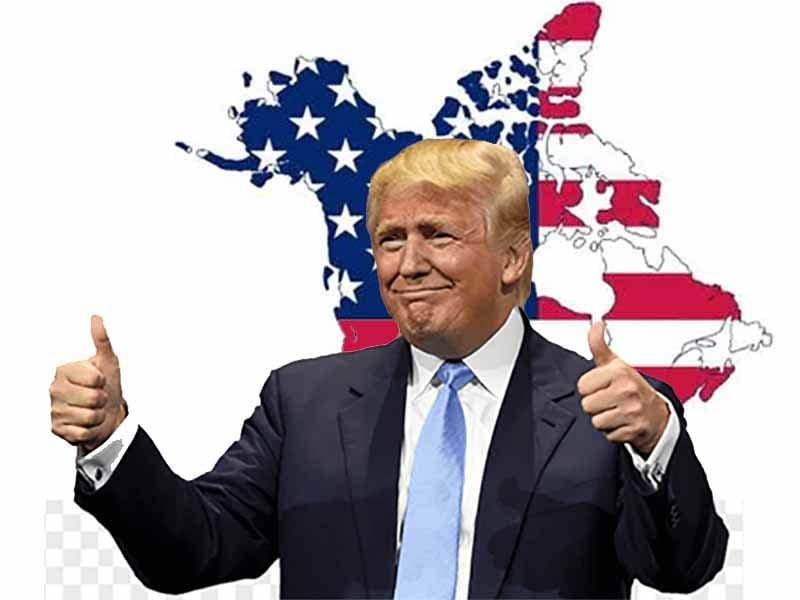- President-elect Trump proposes Canada join the U.S. as its 51st state.
- Trump claims merger would boost security and eliminate trade inefficiencies.
- Canadian Prime Minister Trudeau dismisses the idea, calling it implausible.
- Trump hints at using economic strategies, not military force, for integration.
- Canadian leaders and citizens reaffirm their commitment to sovereignty.
President-elect Donald Trump reignited debate on Tuesday by proposing that Canada should become the 51st state of the United States. During a news conference at his Mar-a-Lago resort, Trump emphasized the economic and security benefits of merging the two nations, calling it “a historic opportunity.”
Trump took to his social media platform Truth Social to share visuals of a unified U.S.-Canada map and images of both countries draped in the American flag. “Oh Canada!” he wrote, underscoring his enthusiasm for the concept.
Trump cited trade imbalances and defense costs as primary motivations for the proposal. “The United States can no longer suffer the massive trade deficits and subsidies that Canada needs to stay afloat,” he argued.
The president-elect also highlighted security concerns, pointing to perceived threats from Russia and China. “With Canada as part of the U.S., they would be totally secure from external threats,” Trump stated. He suggested that eliminating tariffs and taxes between the two countries would lead to significant economic growth on both sides of the border.
In an unexpected twist, Trump linked Canadian Prime Minister Justin Trudeau’s resignation announcement to his proposal. “Justin Trudeau knew this was coming, and he resigned,” Trump said, implying that Canada would fare better under U.S. leadership.
Canada Pushes Back
Canadian leaders responded swiftly, rejecting Trump’s suggestion. Trudeau dismissed the idea with sharp words, writing on X, “There isn’t a snowball’s chance in hell that Canada would become part of the United States.”
Pierre Poilievre, leader of Canada’s Conservative Party, echoed this sentiment. “Canada will never be the 51st state of the U.S.,” he said in an interview with CTV News. Poilievre underscored that Canadians value their sovereignty and independence, which are non-negotiable.
Public sentiment in Canada also remains firmly opposed. A poll conducted by Ipsos Canada last year found that over 85% of Canadians oppose any notion of becoming part of the U.S.
Trump’s Economic Strategy
Trump clarified that he has no intention of using military force to integrate Canada. Instead, he proposed leveraging “economic force” to encourage cooperation. “This is about creating opportunities and removing barriers, not conflict,” he explained.
The president-elect also referenced Canada’s reliance on U.S. defense spending. “We’ve spent hundreds of billions to protect Canada. It’s time for them to step up—or join us,” Trump said.
Critics have labeled the proposal unrealistic, pointing to the complexities of merging two nations with distinct political systems, cultures, and economies.
Trump’s remarks have intensified tensions between the two nations. Canadian leaders see the proposal as a challenge to their sovereignty, while U.S. analysts view it as another example of Trump’s unconventional approach to diplomacy.
This is not the first time Trump has floated controversial territorial ideas. He previously suggested purchasing Greenland from Denmark, a proposal that was also widely dismissed.
Trump’s rhetoric has drawn criticism for undermining the longstanding partnership between the U.S. and Canada, which is based on mutual respect and shared interests. Despite the controversy, trade and security cooperation between the two nations are expected to continue.
Final Thoughts
Trump’s proposal to merge Canada with the U.S. has sparked a significant backlash, highlighting the deep divide between his vision and Canadian sovereignty. While the idea has little practical support, it reflects Trump’s broader strategy of leveraging economic pressure in international relations.
As Trump prepares to take office, his comments have added a provocative twist to U.S.-Canada relations. For now, the two nations remain partners—not one country under the same flag.


